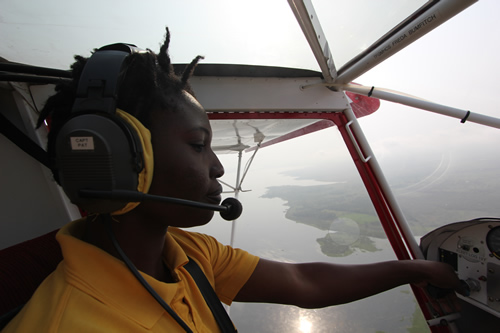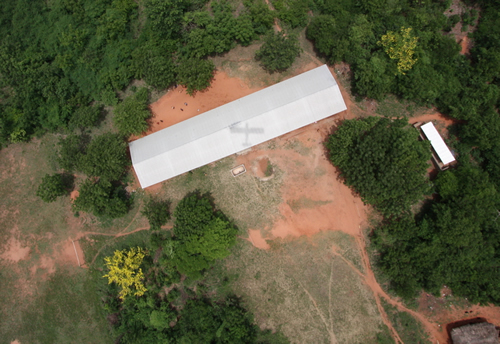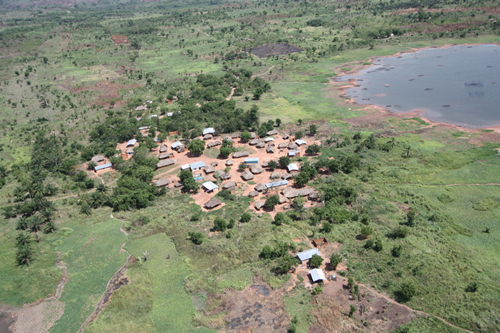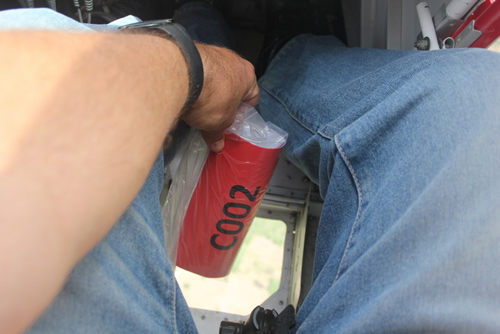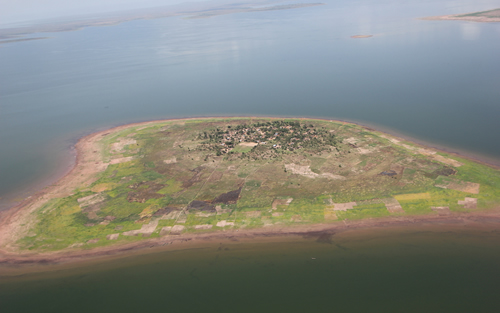The Land That Forgot About Planes, Part 2
By Jonathan Porter, EAA 1157136
Last month I wrote about how I got to Ghana, the flights with President Jerry John Rawlings, and the final approval to build Kpong Airfield. Staffing really was the major, number one migraine! We would cut the runways by hand with machetes and hand-remove tree stumps to clear the safety areas and extend the runways.
However, it is really not easy finding the right people in an area where aviation is practically magic and where the concepts of a runway, runway end safety area (RESA), apron, or fence in a straight line are totally new.
To make matters more challenging, my son, Matthew, had a car crash – not far from the airfield – breaking about 20 bones and leaving him holding onto his life – and his limbs – by a very fine thread. Many people suggested that I give up, but I am not good at that and don’t think I ever will be.
Just as the challenges appeared to grow beyond my coping point, a young lady walked out of the bush. Although I am a persistent person, I am not always a polite person. “What do you want?” I barked. “A job,” she replied. “Shove off – we don’t employ women,” I retorted, turning around and walking away. (In the culture of the area, it was certainly not a woman’s job developing an airfield.) I was already having a bad day.
“I will work for free,” she offered. I stopped, picked up a pickaxe and a machete, and gave them to her. “Then start by clearing some trees.”
But she had not completed her contractual offer: “I will work for free…if I can get closer to the aeroplanes.”
Patricia had seen aircraft on training sorties, carrying out “engine failure after takeoff” practice whilst she was collecting firewood for the family with whom she lived. The little mud hut hamlet she called home, just a kilometre from the end of the runway, was simple, and she had become enthused by the machines flying overhead – and she wanted to know more. We struck a working deal!
Moving across the field to what today is the main apron of the facility, she positioned herself among the menfolk. Choosing her first tree to uproot, she looked around it, gauged it, and then swung into it. Chippings flew, branches fell, and soon that tree was history. It was as if the tree succumbed to her persistence, knowing that giving in quicker was wise in the presence of such a strong young lady. The men could not keep up. Patricia quickly proved that giving up was not in her mentality and that she wanted to prove she could do it better than the others. She succeeded.
A few weeks later, I caught the young male apprentice stealing in the aircraft workshops, and I sent him to the police station. Meanwhile, this unassuming young lady was clearing weeds near the workshop entrance. I called her over to help – and she simply shone in the workshop – practical, intuitive, and ready to learn. She changed the employment situation, turned the staff into principally female, and today is the managing director (CEO) of the company, building planes, instructing, flying, maintaining, and driving tractors and is now also my wife. Today I am the only male working at the site full-time, where I provide technical support to her team!
The airfield compares admirably to any other light aviation facility in the world, but our operations are quite different. We build the Zenith CH 701 aircraft and fit them with Rotax 912 engines. We fitted the first Rotax 912iS engine in Africa – and the first one in a Zenith airframe. Patricia is the first woman certified by Rotax Aircraft Engines, and together we have resolved many issues in making things work in tough conditions.
9G-ZAF is our Rotax 912iS–powered Zenith CH 701 workhorse. Whether we are using it for aerial photography, agricultural survey, or a flying lesson, it generates some income toward its humanitarian role of aerial supply of health education materials.
So come with me on a drop day, and taste what we have achieved from the days of making the masses laugh at the concept of Ghanaians building and flying aircraft to helping develop their own nation.
We live on the 44-hectare (100-acre) site in a simple home: two bedrooms, each 13-by-13 feet (the size of a standard mud hut), a lounge of the same size, and both the kitchen and the bathroom are 6-by-8 feet. We have no mains power, but enjoy mains water, most days. There are no fixed line telephones anywhere near us, but erratic mobile coverage provides communications and Internet – again, most days.
Living close to the centre of the world, at least on the average map at N06°06 E00°03, we are on Zulu time, have roughly 12-hour days and temperatures of 30°C to 40°C (86°F to 104°F) all year around, and live amongst malaria, cholera, schistosomiasis, tuberculosis, and now the constant threat of Ebola!
The sun shines across the airfield and through the bedroom window at 5:30-ish every day. We are generally up before then, thanks to the dawn chorus that seems to start 30 minutes before dawn. The hornbills make a terrible racket, as do the pied crows dancing on the sheet metal roof! But if we do manage to sleep through nature’s song and dance routine, the bright, fast-moving African sun fixes that, as it blasts through the window and illuminates the bed as well as heating the contents of the room to “low heat” in a bread oven!
Up and dressed, the animals come next. We feed the chickens and dogs and then hit the workshops. Whether it is making something on the lathe, mill, or CNC plasma cutter – something always needs to be made. Today, we will cut the blades for the mower, and Patricia will mow the runway ready for operations. Importing things is a major challenge (shipping, duties, and hassles), so we make them if we can. Mower blades get formed out from sheet metal or leaf springs, cut on the plasma, and then hand-shaped with a grinder and balanced before fitting.
Whether on the little John Deere or the vintage tatty blue Ford 3000 tractor, mowing can take up to 40 hours of labour to cover the whole site. We regularly spend more money on mowing and repairs than we return in paid-for flights, but we need the runways working for our humanitarian operations. Nothing beats mowing your own runway. You learn to appreciate every dip and slope. You also spot issues developing, such as termite mounds, holes dug by local fauna, and the odd sandpiper’s nest in the middle of the threshold.
Mowing done, it is back to preflight 9G-ZAF. She is the wonder plane. Her Rotax 912iS engine is the sweetest powerplant you have ever flown behind, so smooth across the entire power range – sipping mogas as if she is the politest young lady at a hydrocarbon cocktail party. We average about 12 litres (3 U.S. gallons) per hour, for 100 hp! But most important, you add power and you get it – from any power setting – and you know that you will.
Before we start, we need clearance from the international airport. Not a single flight occurs in the country’s airspace without prior approval. So, we call in our flight plan and generally get the verbal “mission approved” within a minute. That is a great improvement on the early days – and proof of a nation embracing light aviation.
Climbing into the cockpit, we see the shiny instrument panel and simple VFR, with its Stock Flight Systems 912iS EMU (engine management unit) screen, providing real-time health checks on the engine and full postflight analytical reporting – all compact, and most important, without any “ventilation holes” at the rear of the unit. Wasps, ants, and other insects, not to mention humidity, have spoiled so many expensive pieces of equipment. But the Stock unit is sealed, as robust as an armoured tank, yet with the precision and repeatability of NASA’s best telemetry equipment!
Before we start, we use a modified World War II checklist (I learned it when I flew a Tiger Moth), TFGMHCS – throttle, trim, temperatures, fuel (pumps and volumes), flaps, full and free, gyros, gauges, manage and monitor ECUs (Lane A and Lane B), hatches and harness, clearances and comms, safety and security. We use the same mnemonic for pre-start and power checks.
So, with all checks clear, we are ready to start. One press of the start button and the engine sings sweetly. We taxi slowly to the threshold of 19 and wait for the oil temperature to reach 50°C (122°F). A final TFGMHCS and we are ready to apply power. Patricia is sitting in the left seat, and I’m in the right.
Patricia at the controls
She slides the throttle forward, the engine surges, and before 10 metres have slipped under the nose gear, it is hanging in the air, begging to climb toward the clouds. She skillfully balances on the mains, keeping the angle of attack shallow for quicker acceleration, and then as we hit about 30 kts, with less than 100 metres of runway consumed, we have liftoff. We remain in the ground effect, stable as a flying carpet, just kissing the tops of the grass with the 18-inch tires, and then at 50 kts, we climb, or rather ascend, like a lovesick angel.
Before the end of the runway, we easily clear 300 feet and turn out toward the north. Power is brought back to 97 percent and the ECO mode kicks in, but you are hard pressed to perceive any reduction in power.
We are heading to the Afram Plains. An area with around 200,000 people in nearly 1,000 villages and hamlets, mostly without any roads, power, or potable water supply – let alone telephone coverage. If you wanted to film 16th century Europe, you could probably pass these communities off as comparable. The first village is less than 80 kilometres (50 miles) from the airfield. The trip is about 30 minutes flight but over 20 hours in a car plus a long walk.
We climb to at least 2,500 feet to cross the Akwapim-Togo Ridge, a transit with no viable options to land in the event of an emergency. We fly to the bottom of the cloud base to give us the maximum option set as we look down at the steep slopes and heavy forest below us. Transit takes just a few minutes and we start to cross the open water.
Lake Volta is massive, four hundred kilometres long with a surface area in excess of 8,000 square kilometres. It is manmade and still has trees sticking out, like the skeletal hands of a million drowned guardians reaching upwards as they continue to try to protect their space, more than 50 years after being drowned.
Our life vests are securely in place and we scan the horizon for the coast of Dwarf Island. We spot it, eerily appearing out of the dust-filled sky. Patricia starts to reduce power and aims to fly 500 feet above the surface, using the GPS terrain warning as a guide. There are no accurate maps of this place – none. Communities can move as the water levels change, and there are no roads to use as references. The few roads that exist are simply dirt, and they wash away, get grown over, or even get planted on!
We rely on our Garmin GPS as we scan the horizon for small villages. We use a 295 still but want to upgrade to the 795 as soon as funds permit. Our Aircraft Spruce wish list is very long, indeed! Interestingly, almost every village has a little school – and a school yard or playing field.
Drop zone over school
These clearings in the forest canopy help us to spot a potential site – and a known location of somebody able to read. We fly toward a collection of thatch roofs on mud-walled homes. Some children can be seen in the cleared area. We have target acquired. I collect a health education pack from the baggage rack. Patricia starts to slow the plane from 70 kts to 50 kts; we assess together the drop zone, calling out any dangers. We evaluate the wind from the smoke coming from a village fire.
A typical drop village
Patricia pulls the power right back and drops the plane down to 200 feet over the edge of the drop zone. The children are mesmerised at the metal bird swooping in on them. They have heard of it, for all of Ghana has now heard about the metal planes built by the crazy Ghana Girl (that would be Patricia), and then as the aircraft reaches 35 kts, I release the package.
Drop bag ready to release
Smoothly, Patricia adds power, and we climb away. At 500 feet we turn and watch as the children run with the package toward the school building. Health will be the topic of the day for these youngsters!
As soon as we are at a safe height, we do a FREDA: fuel, radio, engine, direction, altitude, attitude, and airframe check. Our specially adapted fuel system allows us to feed all four wing tanks to a header tank simultaneously and to visually monitor flow from each tank. Monitoring such things is important, but flying the plane comes first, especially when flying at low levels!
We spot another village, repeating the same procedure, and another, and another…The villages are so many, and the people are so incredibly much in need of something more than just a dropped package of health education posters. They need something that airplanes are good at – perhaps best at. They need inspiration.
It is a privilege beyond belief. With over 50 packages dropped, Patricia climbs us back up to 2,500 feet. We are exhausted. Operating at low levels, with a relatively high number of potential challenges, takes its toll mentally, as does targeting. But it is all made up for by the knowledge that our flight has changed lives.
Island communities are easy to spot
We route back through the Volta region and fly along the Volta River to our home base, and we prepare to land.
Patricia smiles as she handles the turbulence coming through 300 feet. She is used to it. The plane drops and she adds power; the plane climbs and she reduces it again. Without her being so smooth and responsive, we could find ourselves in the trees. But she knows that and loves every minute of it. The wind sock spins 90 degrees and we adjust our approach, coming close to the ground and solidly taking hold of the flare.
Reducing power, Patricia continues to pull back on the stick. We feel the vortex generators starting to work on the elevator, and we recline in our seats as we roll out, nose high, using the wings as brakes.
After lunch, we fix fences, teach some welding to youngsters, produce some new mounting brackets, and then as the sun plunges rapidly from its heights to the horizon, splashing its reddish African tints across the sky, we head home before becoming snacks to the mosquitoes that spread malaria.
By 1815 hours, it is dark. Dark is a funny expression when the moon is bright and the stars seem to be hanging like fireflies in the sky, all accompanied by the song of the crickets and frogs declaring that the day is over.
By 2000 hours, we are wiped out, sleeping, and preparing our bodies for another day of challenges. We don’t do drops anywhere near as often as we would like, currently just a few runs per year, due to lack of funds, but we are working toward better days and soon hope to be granted permission to land in rural communities as well.
And we remain constantly alert, seeking new and creative ways to change lives through light aviation. As we say here, “changing lives, one flight at a time” is what it is all about!
You can find out more about Jonathan and Patricia at www.MedicineOnTheMove.org, and they will soon be releasing a book to raise funds for their next project.
